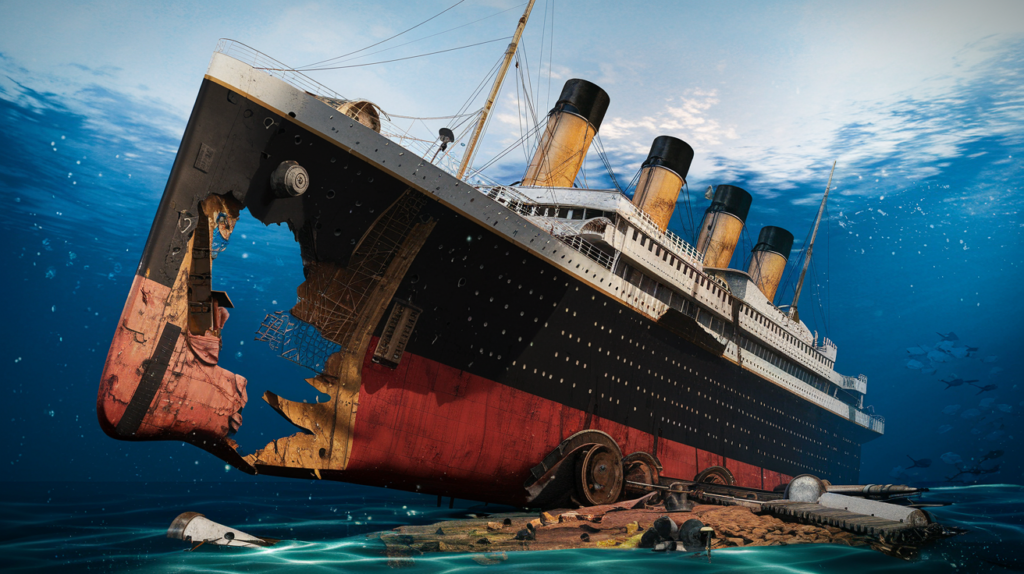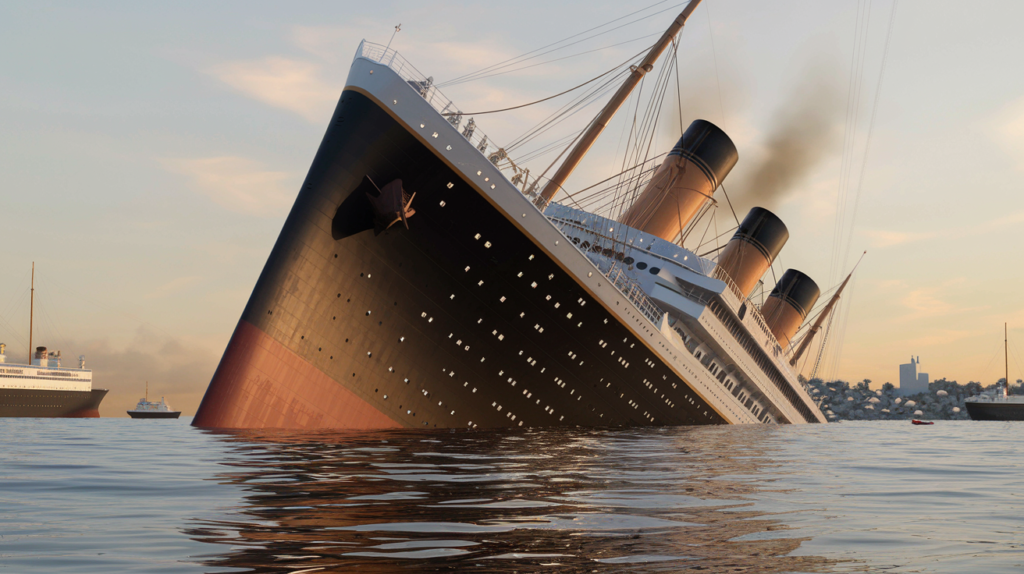Daily Mirror Over a century after the Titanic’s tragic sinking, a historic newspaper has emerged from a forgotten wardrobe, rekindling memories of that fateful night. The Titanic, once praised as “practically unsinkable,” stands as one of the most devastating maritime disasters ever recorded.When the ship struck an iceberg during its maiden voyage in the icy waters of the North Atlantic, more than 1,500 people lost their lives. Although the ship carried lifeboats, many launched half-empty due to the widespread belief that the Titanic could not sink.
Recently, someone discovered an extraordinary find in Lichfield, Staffordshire. A newspaper from April 20, 1912—just five days after the disaster—was found in a wardrobe. This edition of the Daily Mirror captured the heart-wrenching aftermath of the Titanic tragedy and vividly portrayed the grief of the families in Southampton, where most of the ship’s crew lived. These families anxiously awaited news, hoping their loved ones had survived. Hanson’s Auctioneers, who sold the newspaper for £34 on August 20, called it a “valuable piece of social history.”
Daily Mirror: Historic Titanic Newspaper Discovered After 112 Years
Charles Hanson, the auction house’s owner, emphasized the profound emotional impact of the discovery. He noted that while countless films, TV shows, and books have documented the Titanic story, this newspaper highlights the real human cost of the disaster. The faces of the grieving families and the lost lives reveal a story that words alone cannot fully convey.

Daily Mirror edition Titanic newspaper
Southampton felt the Titanic’s sinking particularly hard. The Daily Mirror captured the heartbreaking scene outside the White Star Line’s offices, where survivors’ lists were posted. Desperate mothers, wives, and sweethearts scanned the names with hope, praying their loved ones had survived. Sadly, many faced their worst fears. The newspaper described the day as “a terrible day in the history of the town,” marking the end of a torturous wait but confirming the profound loss for countless families.
The cover story included a two-page spread with photographs of the victims, including the ship’s captain, Edward Smith. These images added a personal, human touch to the cold statistics of lives lost at sea. The newspaper’s focus on the families left behind makes this historical artifact particularly moving, as it shifts the attention from the event itself to the enduring impact on those who mourned.
Alongside the Titanic newspaper, the discovery also included other historical documents, such as articles about King George V’s coronation in 1911. This treasure trove of history shows how forgotten relics from the past can resurface, offering a glimpse into the lives and emotions of those who lived before us. Auctions like the one hosted by Hanson’s Auctioneers play a crucial role in preserving and showcasing these significant pieces of history for future generations.

The Auction: How Historical Artifacts Find New Homes
On August 20, 2024, the Titanic newspaper discovered in Lichfield was sold at auction for 34 pounds. While the sum may seem modest, the significance of the sale extends far beyond the monetary value.Auctions like these provide a fascinating glimpse into the world of historical artifacts. They showcase items from the past that find new homes and receive preservation for future generations. But what exactly makes an artifact valuable, and how do these items end up being auctioned?
The process begins with the discovery of an item, often by someone who had no idea of its historical importance. Once the item is identified, experts at auction houses like Hanson’s Auctioneers assess its value. Factors such as rarity, condition, and historical significance play a crucial role in determining an artifact’s worth. Some items, like the Titanic newspaper, carry emotional weight as well, adding to their appeal for collectors.
During Daily Mirror the auction, bidders compete to acquire these artifacts, with some items fetching astronomical prices. However, even more modestly priced items like the Titanic newspaper hold immense historical value. The sale of such items ensures that they are preserved, studied, and appreciated by those who understand their significance. The auction process is not just about commerce; it is about the preservation of history and the continued exploration of the past.
For the Titanic newspaper, its sale represents the journey of a historical artifact from discovery to preservation. It will now join other Titanic-related items in private collections or museums, where it will continue to tell the story of the Titanic disaster and the impact it had on the world. Auctions like these ensure that history remains alive and accessible, allowing future generations to learn from and connect with the past.
The Daily Mirror’s Titanic Coverage: A Window into the Past
The pages of the Daily Mirror edition dated April 20, 1912, offer a raw and emotional glimpse into the immediate aftermath of the Titanic disaster. The front-page story captures the anguish of the relatives of Titanic passengers, many of whom were from Southampton. As the residents gathered outside the White Star Line’s offices, they were desperate for any news of their loved ones. Lists of survivors were posted, and with each name that appeared, hope either flickered or was extinguished. The newspaper vividly described the scene, where mothers, fathers, wives, and sweethearts anxiously scanned the lists, hoping against hope that their loved ones had survived.
The Daily Mirror coverage also provided insight into the human toll of the disaster. The paper did not merely report on the sinking of the ship; it highlighted the impact on the families left behind. The article spoke of the heart-wrenching wait for news and the devastating realization for many that their worst fears had come true. The emotion in the writing is palpable, as it brings to life the grief and despair that consumed entire communities in the wake of the disaster.

In addition to the written coverage, the newspaper included photographs of some of the victims, including the Titanic’s captain, Edward Smith. These images added a deeply personal dimension to the catastrophe, putting faces to the names of those who perished. The photographs, coupled with the heart-wrenching accounts of the families’ wait for news, served as a stark reminder of the real human cost of the disaster. The Daily Mirror captured the raw emotions of a world in mourning, offering readers a window into the past that still resonates today.
The Discovery: A Historical Gem Hidden for Over a Century
In August 2024, an extraordinary discovery was made in the town of Lichfield, Staffordshire. While sorting through an old wardrobe in a modest home, a resident stumbled upon an artifact that would transport them back in time—a newspaper chronicling the Titanic disaster. This An edition of the Daily Mirror, dated April 20, 1912, was discovered more than 112 years after its initial printing. The paper detailed the events from five days earlier, when the Titanic sank in the icy waters of the North Atlantic, leaving the world to grapple with the magnitude of the tragedy.
The homeowner, unaware of the significance of the newspaper at first, soon realized that this was no ordinary find. Preserved for over a century, this fragile piece of history offered a direct connection to one of the deadliest maritime disasters in history. The pages of the Daily Mirror held the raw emotions and confusion that the world felt in the immediate aftermath of the Titanic’s sinking. As we look back at this discovery, we are reminded of how history can linger in the most unexpected places, waiting to be uncovered.
The newspaper was in surprisingly good condition, considering its age and the circumstances under which it had been stored. The images and articles it contained offered a vivid glimpse into the past, capturing the anguish of the families who awaited news of their loved ones and the collective mourning that swept across nations. This discovery reignited interest in the Titanic and its place in history, proving that even after more than a century, the story of the Titanic continues to resonate deeply with people around the world.
The Titanic’s Legacy: A Tragedy That Echoes Through Time
The RMS Titanic remains one of the most enduring symbols of tragedy and human error. The ship, proudly touted as “practically unsinkable,” left port on its maiden voyage with a sense of optimism and wonder. It was the epitome of luxury, engineering marvels, and the promise of safe passage across the Atlantic. Yet, despite all the fanfare, the Titanic met a fate that stunned the world. On the night of April 14, 1912, just days into its journey, the ship struck an iceberg. In less than three hours, it sank to the depths of the North Atlantic, claiming the lives of over 1,500 passengers and crew.
This tragedy didn’t just shock those who witnessed it; it reverberated across the globe. The loss was immeasurable, but so too were the lessons learned. The Titanic disaster highlighted the fatal consequences of overconfidence in technology and the lack of preparedness in crisis situations. The ship had been equipped with far too few lifeboats, and even those were not fully utilized due to the prevailing belief that the Titanic simply could not sink.
Even more than a century later, the story of the Titanic continues to fascinate. It serves as a poignant reminder of human vulnerability in the face of nature’s power. Movies, books, and documentaries have kept the memory of the Titanic alive, ensuring that this disaster, while tragic, remains a powerful story of loss, survival, and the enduring spirit of the human race. Every new discovery related to the Titanic offers fresh insights and reignites public interest in this monumental event in maritime history.

Lichfield: A Town Steeped in History
The discovery of the Titanic newspaper in Lichfield, Staffordshire, added yet another fascinating chapter to the town’s rich history. Known for its stunning medieval cathedral and as the birthplace of literary figure Samuel Johnson, Lichfield has long been a place where history and culture intertwine. This quiet town may seem far removed from the icy waters of the North Atlantic where the Titanic met its fate, yet the discovery of this newspaper in an old wardrobe serves as a reminder of how history can leave its mark in the most unexpected places.
Lichfield has a deep connection to the past, with its streets and buildings echoing stories from centuries ago. This small town, with its cobblestone streets and charming atmosphere, has witnessed countless historical events over the years. But the discovery of the Titanic newspaper brings a different kind of history to light—one that transcends geographical boundaries and connects the town to a global tragedy.
The preservation of historical artifacts in towns like Lichfield highlights the importance of everyday discoveries. Often, it is in these quiet corners of the world where pieces of history are kept safe, waiting to be uncovered and shared with the wider world. The newspaper found in Lichfield not only tells the story of the Titanic disaster but also adds to the town’s narrative, linking it to one of the most significant events of the early 20th century. It reminds us that history happens not only in grand palaces and battlefields but also in the homes of ordinary people. There, the past quietly lingers, waiting for someone to rediscover it.

Southampton’s Tragic Loss: A City in Mourning Daily Mirror
Southampton, a bustling port city on the southern coast of England, was deeply connected to the Titanic. The ship’s departure from the city on April 10, 1912, was a grand event, with crowds gathering to see the magnificent liner off on its maiden voyage. But just days later, Southampton would be plunged into mourning as news of the Titanic’s sinking reached the city. Southampton had supplied a large portion of the ship’s crew, and the loss of life among the city’s residents was staggering.
When the news broke, families rushed to the White Star Line’s offices in Southampton, desperate for any information about the fate of their loved ones. People posted lists of survivors, but many could not find the names they hoped to see. Grief-stricken families filled the streets outside the offices, holding onto the last shreds of hope. The Daily Mirror captured the scene in vivid detail, describing how mothers, wives, and daughters anxiously scanned the lists, only to encounter heartache and despair.
Southampton was hit harder by the Titanic disaster than any other city. The loss of so many lives left a lasting impact on the community. The city became a place of mourning, with entire streets losing husbands, sons, and fathers. The Titanic’s sinking was not just a global tragedy; it was a deeply personal one for the people of Southampton. The community banded together in their grief, but the loss was palpable, and the scars left by the disaster would remain for generations. Southampton’s connection to the Titanic is still remembered today, with memorials throughout the city honoring the crew members who never returned home.







